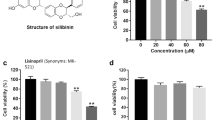Abstract
Transforming growth factor-β (TGF-β) is closely associated with progressive renal fibrosis. A central component of TGF-β-stimulated mesangial cell fibrogenesis is the TGF-β family-specific Smad signal transduction pathway. This study investigated the expression of TGF-β-receptor–activated Smad2, its common partner Smad4, and the phosphorylated Smad2 (p-Smad2) in adriamycin-induced toxicity of cultured rat mesangial cells. This in vitro study showed that amlodipine (10−9 to 10−5 mol/l) had no effect on the toxicity of rat mesangial cells induced by adriamycin in the absence of TGF-β1. However, amlodipine (10−7 to 10−5 mol/l) reduced the toxicity of rat mesangial cells induced by TGF-β1 in the absence of adriamycin; moreover, amlodipine (10−8 to 10−5 mol/l) significantly reduced adriamycin-induced cytotoxicity when it was given in combination with TGF-β1; amlodipine (10−6, 10−5 mol/l) had no effect on Smad2 mRNA and protein expression induced by adriamycin + TGF-β1, but it (10−6, 10−5 mol/l) dramatically inhibited the down-regulation of p-Smad2 protein expression as well as Smad4 mRNA and protein expression induced by adriamycin + TGF-β1 in rat mesangial cells. Present study shows that amlodipine exerts a significant inhibition on adriamycin-induced toxicity in rat mesangial cells by affecting the expression of TGF-β/Smad signaling intermediates p-Smad2 and Smad4.







Similar content being viewed by others
References
Bakris GL, Weir MR, Secic M, Campbell B, Weis-McNulty A (2004) Differential effects of calcium antagonist subclasses on markers of nephropathy progression. Kidney Int 65:1991–2002
Baroni EA, Costa RS, Volpini R, Coimbra TM (1999) Sodium bicarbonate treatment reduces renal injury, renal production of transforming growth factor-beta, and urinary transforming growth factor-beta excretion in rats with doxorubicin-induced nephropathy. Am J Kidney Dis 34:328–337
Border WA, Noble NA (1997) TGF-β in kidney fibrosis: a target for gene therapy. Kidney Int 51:1388–1396
Border WA, Noble NA (1998) Evidence that TGF-β should be a therapeutic target in diabetic nephropathy. Kidney Int 54:1390–1391
Cheng J, Grande JP (2002) Transforming growth factor-beta signal transduction and progressive renal disease. Exp Biol Med 227:943–956
Constance ER, Schnaper HW, Poncelet AC (2005) The role of internalization in transforming growth factor1-induced smad2 association with smad anchor for receptor activation (SARA) and smad2-dependent signaling in human mesangial cells. J Biol Chem 280:8300–8308
Huang XR, Chung CK, Wang XJ, Lai KN, Lan HY (2008) Mice overexpressing latent TGF-β1 are protected against renal fibrosis in obstructive kidney disease. Am J Physiol Renal Physiol 295:118–127
Kaynar K, Ulusoy S, Ovali E, Vanizor B, Dikmen T, Gul S (2005) TGF-β and TNF-α producing effects of losartan and amlodipine on human mononuclear cell culture. Nephrology 10:478–482
Lai YM, Fukuda N, Su JZ, Suzuki R, Ikeda Y (2002) Novel mechanisms of the antiproliferative effects of amlodipine in vascular smooth muscle cells from spontaneously hypertensive rats. Hypertens Res 25:109–115
Liu LL, Li QX, Xix L, Li J, Shao L (2007) Differential effects of dihydropyridine calcium antagonists on doxorubicin-induced nephrotoxicity in rats. Toxicology 231:81–90
Mason RP, Mak IT, Trumbore MW, Mason PE (1999a) Antioxidant properties of calcium antagonists related to membrane biophysical interactions. Am J Cardiol 84:16–22
Mason RP, Walter MF, Trumbore MW, Olmstead EG, Mason PE (1999b) Membrane antioxidant effects of the charged dihydropyridine calcium antagonist amlodipine. J Mol Cell Cardiol 31:275–281
Miyazawa K, Shinozaki M, Hara T, Furuya T, Miyazono K (2002) Two major Smad pathways in TGF-β superfamily signalling. Genes to Cells 7:1191–1204
Pablo I, Josep MC, Sergio L, Carlos P, Begona C, Monica B, Fedrico O, Francisca R (2001) Effects of losartan and amlodipine on intrarenal hemodynamics and TGF-β1 plasma levels in a crossover trial in renal transplant recipients. J Am Soc Nephrol 12:822–827
Schnaper HW, Hayashida T, Hubchak SC, Poncelet AC (2003) TGF-β signal transduction and mesangial cell fibrogenesis. Am J Physiol Renal Physiol 284:243–252
Tamaki K, Okuda S, Ando T, Iwamoto T, Nakayama M, Fujishima M (1994) TGF-beta 1 in glomerulosclerosis and interstitial fibrosis of adriamycin nephropathy. Kidney Int 45:525–536
Tobe S (2003) Update on calcium antagonists and the kidney. Curr Opin Nephrol Hypertens 12:309–315
Acknowledgments
This work was supported by a research grant (No.30772680) from the National Natural Science Foundation of China.
Author information
Authors and Affiliations
Corresponding author
Rights and permissions
About this article
Cite this article
Song, YJ., Li, J., Xie, XF. et al. Effects of amlodipine on TGF-β-induced Smad2, 4 expressions in adriamycin toxicity of rat mesangial cells. Arch Toxicol 85, 663–668 (2011). https://doi.org/10.1007/s00204-011-0667-4
Received:
Accepted:
Published:
Issue Date:
DOI: https://doi.org/10.1007/s00204-011-0667-4




